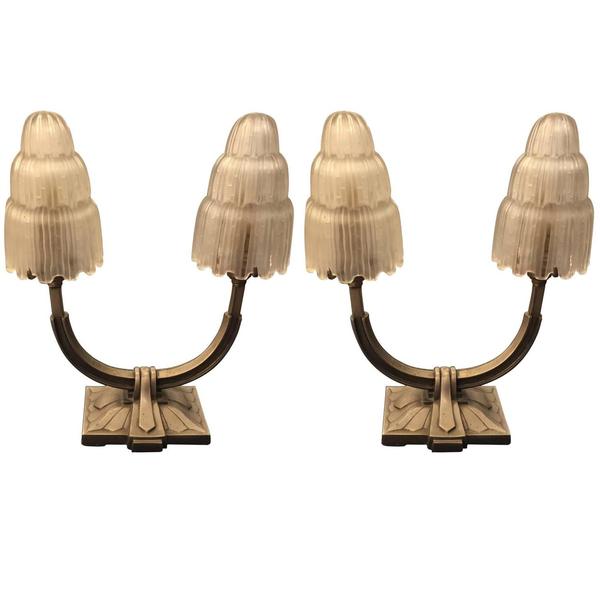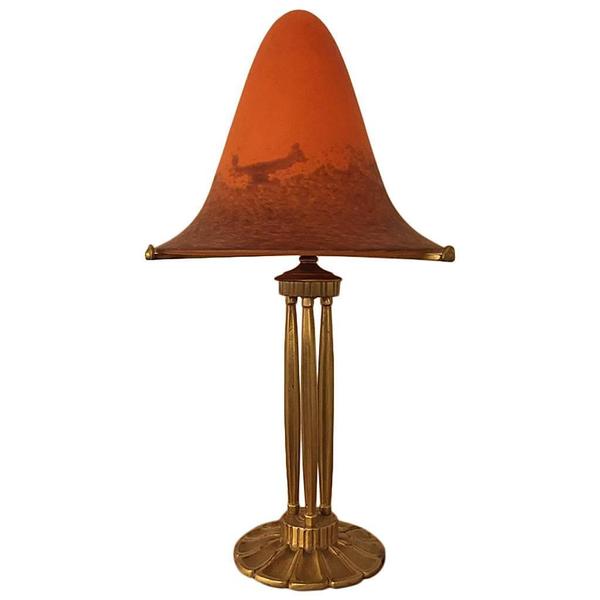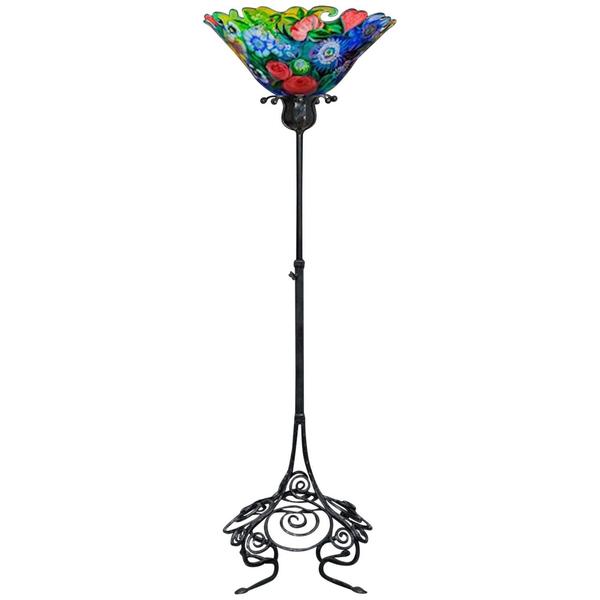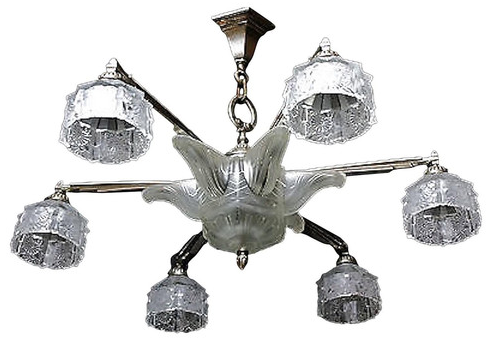4 Tips to Caring for Your Chandelier 0
Taking care of a chandelier can be a tricky job, especially if it's an original and not a replica or knock-off. To keep your chandelier (or chandeliers) in beautiful and great condition, here are 4 tips to follow.
1. Weekly dusting
Chandeliers are notorious dust-traps, attracting dust and insects all the time. They can quickly get dull and the light can become dimmer over time as a result.
Don't just wave a duster at it though, as the dust will simply fly into the air and resettle on your chandelier. Use a soft cloth or a static-free duster every week to remove excess dust, and don't be afraid to get on a ladder and get up close and personal.
Whatever you do, just be careful and, if you are using a ladder, make sure it's secure and there's someone nearby to help stabilize you.
2. Monthly inspections
The older a piece is, the more susceptible it is to rust, temperature fluctuations and other potential damage. It's a good idea to inspect the chandelier once a month, or at least once every two months.
Check any glass, crystal or perspex pieces for chips and cracks. Take a look at (but please don't touch!) the wiring to make sure nothing has become frayed or exposed.
Also look at any metal part, including chains, hooks or links, to make sure they aren't bent, broken or rusted.
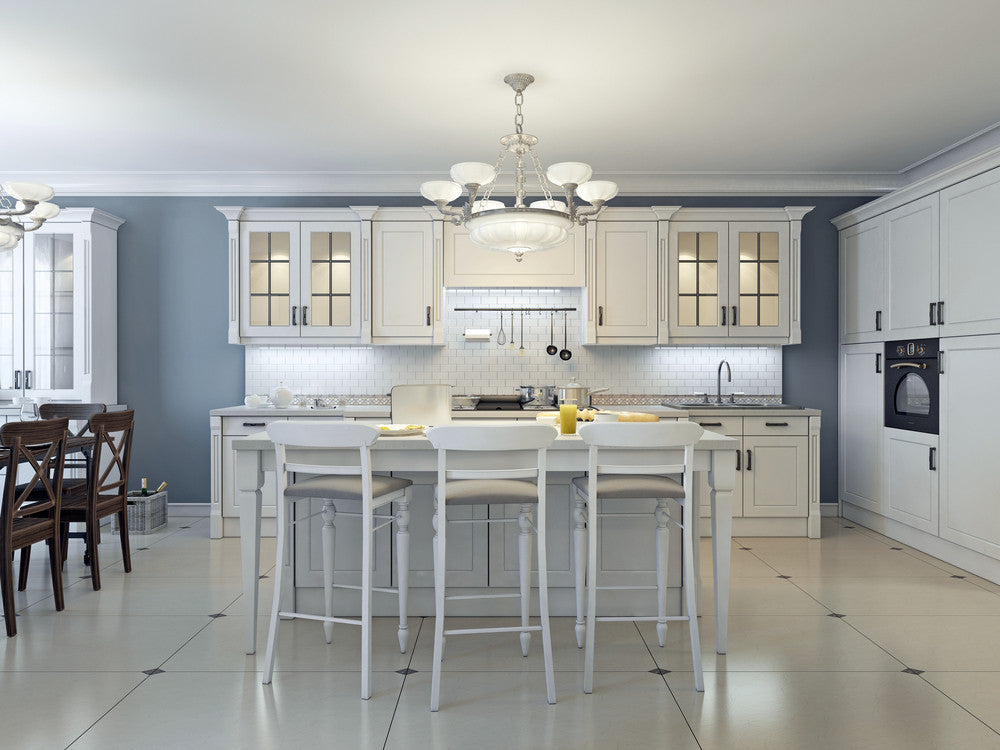
3. Seasonal deep cleaning
This is something that should be done seasonally, or at a minimum every six months.
The more intricate the chandelier and the more pieces it has, the less often you may want to do it to avoid accidentally breaking parts.
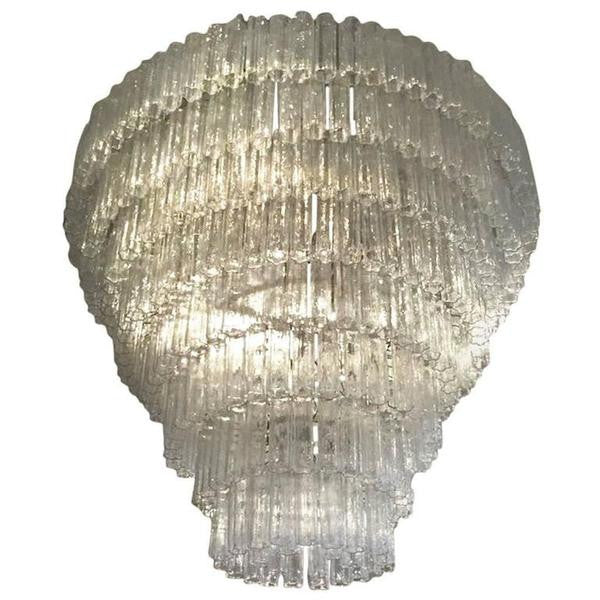
Italian Mid Century Round Eight Tired Tronchi Chandelier
If your chandelier includes many glass, crystal or perspex parts, you'll want to carefully wash those in warm, soapy water every three to six months.
The timing can also depend on where in the house the chandelier is - for example, those in the kitchen will build up humidity and grease a lot more quickly that those in the bedroom.
Take your time dismantling and washing the pieces, then reassemble it when everything is completely dry. If the ceramic or other hardware parts are fragile, very delicate or have any age damage, you'll want to do this process less often.
4 - Call a professional
While it's admirable to take personal care of your Art Deco or Mid-Century Modern chandelier, there's absolutely no reason not to use a professional for the cleaning.
We're quite confident anyone should be able to manage the dusting, but maintenance and deep cleaning can present challenges for non-experts.
French Art Deco Brass and Nickel Chandelier
Get to know the materials your chandelier is made out of and learn what cleaning products are best suited to their care.
Remember that vintage and antique pieces will be made from different materials, or that the materials will have undergone different processes to modern pieces, and this can affect their cleaning and maintenance needs.
If you have any doubt at all, go ahead and call in a professional. The store where you bought your genuine Art Deco or Mid-Century Modern chandelier should have a list of providers they trust to take care of their pieces, and will happily recommend them to you.
Keep Your Lights Shining Bright 0
A 1-2-3 guide to cleaning and caring for Art Deco chandeliers, light fittings and lamps
Bronze
So you've finally chosen and installed your Art Deco lighting. You're surrounded by the soft, gentle glow of sconces, ceiling lights and table lamps that reflect your love for this fantastic decor art form.
But, like everything else, they will get dusty and dirty over time and cleaning them may take a little more care than ordinary light fittings. This step-by-step guide will help you take care of your lights and keep them shining.
Step 1: Know your materials
Glass and Silvered Bronze
Art Deco as a design form drew its influences from all over the world and, as a result, its materials came from every conceivable available source - glass, metal, wood, bone, ceramics and fabric could all quite happily coexist in one piece.
One thing you won't find a lot of in genuine Art Deco is plastic, as most polymers only came into use after World War II, but you may find one or two pieces made of Bakelite.
When buying cleaning products to use on your Art Deco pieces, make sure you are buying the appropriate products - pewter cleaner is no good for wood, while wood polish could wreck your beautiful hand-painted glass shade.
If in doubt, ask the seller or an antiques expert to help you identify the various materials.
Step 2: Careful cleaning
Glass and Copper
The easiest way to keep your lights clean is to dust them regularly. Using a soft cloth, wipe them down gently. Don't use a duster, because all the dust will just fly into the air to settle back on the fittings minutes later.
Even with regular dusting, you will still need to occasionally give your pieces a thorough cleaning. Once every six months to once a year should do it, unless you live in a particularly dusty or smoggy area.
Before washing any part of your lamp, such as the glass, crystal or ceramic parts, check it thoroughly for cracks, chips or other damage - especially in the glaze on ceramics. It is very difficult to get such cracks properly dry and this could cause all kinds of further damage.
Make sure you spend some time gently cleaning all the corners, crevices and nooks where grime can accumulate. Use soft cloths, q-tips or very soft-bristled brushes.
Double-check whether wooden parts are varnished or raw. They may need oil rather than polish. If you use oil, stick with oil; if you use wax, stick with wax. Don't switch between the two, as this can cause cloudiness and build-ups.
Step 3: Don't DIY
Painted Glass and Hand-Forged Iron
When the time comes to take down your enormous crystal and pewter chandelier to individually clean all 500 pieces, or when your hand-painted one-of-a-kind sconces are looking a bit dull and you want to give them a wash, don't.
The same goes for those ceramic pieces with the cracked glaze we talked about earlier, or the carved bone filigree piece with thousands of pin-prick holes.
When it comes to the more specialized pieces, if you have even an ounce of doubt, it's better to leave it to the professionals. Genuine Art Deco pieces are usually quite pricey and unique, so it's worthwhile knowing one or two expert cleaning services to help you.
Make sure they really know the style and don't be afraid to ask them for references - and to contact the references! And also feel free to ask them about maintenance between the annual big clean. They will offer the best and most accurate advice.
- Matthew Pillet
- Tags: art deco ceiling light chandelier cleaning french art deco interior design lamp lighting painted glass sconce stained glass
A Brief History of Art Deco Chandeliers 0

Art Deco is certainly a style on its own, one that stands out among the various styles of the twentieth century and one that persists as a viable decor option even today.
In the same way, chandeliers are a decor and design item all to themselves. Any home can certainly have perfectly adequate and even beautiful lighting without one, but a chandelier brings a unique touch of style to a room, anchoring its decor in a way no other item can.
From simple to ornate...

When they made their appearance in medieval times, chandeliers were simple wooden crosses to which candles could be affixed and which could be transported from room to room.
Over time and as artisans developed new techniques in metal work, glass blowing, crystal cutting, chandeliers became more ornate, larger and more intricate. Of course, this also meant they became more expensive and therefore only afforded by the rich, or appearing in larger churches and cathedrals.
Chandeliers quickly became synonymous with wealth and status, something to aspire to. Stately homes' ceilings would virtually groan under the weight of glass, crystal, metal and candles and later gas-fired and eventually electric chandeliers.
... and back again

Right up until the early twentieth century, this was the status quo... and then came along our favorite decor movement which, naturally, turned everything on its head.
Yes, the ornate and stately chandeliers found new life in Art Deco styles, but simpler, more modern and streamlined designs also made their appearance. Here were chandeliers that could fit into more ordinary homes and lend them a touch of opulence and style without literally taking over the room.
These paved the way for the Mid-century Modern low-hanging single-fitting light fixtures and the enormous variety of home chandeliers we see today. But of course, a special place in our hearts will always belong to these pioneers of design and lighting style.
If you want to add some Art Deco chandelier action to your home, take a few things into consideration.
Size matters
Larger rooms can, of course, accommodate larger chandeliers, but bear in mind the height of the ceiling, not just the floor area. The last thing you want is your guests banging their heads on your lovely lighting.
For a smaller room, consider something like this French Art Deco Modernist Ceiling Light Chandelier, which is gorgeous and true to the style, but won't dangle in your dinner.

Material world
Art Deco is Art Deco is Art Deco, right? Well, no. As with any design movement, there are sub-styles, items that work together and items that clash.
Especially if you're going the whole hog, it pays to pay attention to the materials you're using and trying to work out which work together and which fall flat. By contrast, you may not want to overdo it on one type of material.
For example, if your room is feeling a little heavy on the polished wood items, consider something like this incredible pressed glass chandelier from the Verrerie des Hanots.

Above all, have fun with your Art Deco stylings. The design movement represented a new era in design, a movement away from the past and into the future, so don't be afraid to experiment with it and make it your own.
- Matthew Pillet
- Tags: art deco ceiling light chandelier french art deco interior design lighting
Art Deco in Hollywood: Three celebrity homes to get lost in 0
Hollywood's love affair with Art Deco is one that goes back to the early days of both art forms. The first movie filmed in Hollywood was filmed in 1910 and by the time the cinema had picked up in popularity, Art Deco was making its first overtures in France and quickly spreading to the USA. The relationship goes so deep that many of the buildings in Hollywood and surrounding Los Angeles are Art Deco style.
Thanks to movies, it is easier to find Art Deco originals and knock-offs. Even Hollywood's most well-known symbol, Oscar, is designed in Art Deco style. It's no surprise then, that many celebrities choose to build and decorate their homes in Art Deco style. This week, we take a peek inside three of these homes that the Art Deco lover could happily get lost in.
Jennifer Aniston: Beverly Hills
When Jennifer Aniston bought a Harold W Levitt house in Beverly Hills, she decided to transform it into an opulent Art Deco palace in which she could comfortably entertain guests in style and privacy. Designer Stephen Shadley was tasked with bringing Jennifer's vision to life and, after virtually rebuilding the house, it was finally revealed in all its glory.

Source: Architectural Digest
Our favourite? The games room, perfectly set up for entertaining and with its stunning view over LA, it's the stuff of Hollywood fantasy.
To spruce up your entertainment area, what about a beautiful buffet?
Jeremy Renner: Holmby Hills
Everyone's favorite hawk-eyed Avenger, Jeremy Renner, has a fun and interesting sideline – buying, renovating and flipping houses, including a stunning mansion in Holmby Hills that he and his business partner, Kristoffer Winters, sold off in 2013.
Priced at just shy of $25 million, they described the home as a "Roaring 20s Art Deco-style home fit for a 21st century Howard Hughes" – and when you take a look inside, you'll agree. It certainly is a home we could comfortably become recluses in.

Source: Business Insider
Our favourite? Definitely the gents' walk-in closet with its own barber chair and station. Nothing quite encourages enjoying one's home more than being able to get your shave and haircut without leaving the house.
Recline in luxury and celebrate your privacy with luxurious club chairs, fit for a king and queen of cool.
Mickey Drexler: Tribeca
Ok, he's not exactly Hollywood, but the incredible Art Deco stylings of J Crew's CEO's New York home are too good to skip on a technicality.
Drexler went straight to the source for the full-scale rebuild and design of his home – French architect and designer Thierry Despont. Filled with French Art Deco inspiration, including the Maison de Verre in Paris, this five-bedroom former factory is an Art Deco paradise.

Source: Elle Decor
Our favorite? This bedroom. It is flawless Art Deco, from the step-and-repeat wallpaper, to the trimmed pillow covers, to the poster flanked by the symmetrically asymmetrical picture frames containing Art Deco images... this room is a masterpiece and we could happily spend days on end here.
Just because sleep is a necessity doesn't mean it can't also be a luxury. Cradle yourself in style with an Art Deco bed.
- Matthew Pillet
- Tags: art deco french art deco
Art Deco How-to: 3 Tips for Lighting Up Your Space 0
We've said it before, and we'll say it again – clever use of lighting is one of the easiest ways to get started on your Art Deco journey. With a little know-how, you can transform your room's lighting from purely functional to gorgeously glowing in a few simple steps.
Here are three ways to introduce Art Deco lighting to your space.
1. Table Lamps

The beauty of a good Art Deco table lamp is that it not only serves to brighten up a darker corner of a room, but, if you've chosen carefully, it can be a lavish work of art that looks just as stunning in the daytime when the lights are off.
Whether you choose a powerful and evocative piece like this image of Diana the Huntress and her dog, or go for a dramatic geometric piece like this matching pair, your table lamps will cause quite a stir and create a beautiful focal point for your Art Deco adventures.
Top Tip: Place your lighting artwork on the "pedestal" it deserves by pairing it with a unique accent table.
2. Sconces

If you're looking for a bit more function out of your lighting but still want to transform your room into an Art Deco palace, you can't go wrong with a good set of wall sconces. They light up the entire room, without dominating it, but still add that classy décor touch.
If you're looking to make a bold statement, these incredible clear frosted glass sconces will definitely do the job. If you prefer something a little more subdued, but still unmistakably Art Deco, this set by French artist Degue might be more your speed.
Top Tip: Wall sconces incorporate various different geometric designs. While you don't have to match all geometric patterns in your décor, it helps to weave a theme throughout.
3. Chandeliers
If you're feeling adventurous and really want to make a statement with your Art Deco lighting, a chandelier is the way to go.
Ideal for larger rooms or high-ceilinged areas, the right Art Deco chandelier will bring all the opulence and decadence of the 1930s into your space and give you a fantastic focal piece to work around.
Chandelier by Verrerie des Hanots
For larger rooms with higher ceilings, choose something dramatic like this six-armed piece from Verrerie des Hanots.
If your space is smaller, or you have regular ceilings, don't despair! Choose a smaller, yet still stunning, piece like this Lalique "Soleil".
Top Tip: It pays to measure your room's height before shopping for chandeliers. No matter how beautiful and suited to your tastes it is, knocking your head against it will quickly become old – not to mention the chances of breaking the probably irreplaceable glass.
Lighting is a good entrée to any décor style, because it helps you work out which aspects of that style you prefer. With Art Deco, you'll find yourself choosing between bold and delicate, angular and rounded, geometric and step-and-repeat.
Choosing lighting is a great way to gain insight into your own preferences and it's a journey to be enjoyed, every step of the way!
- Matthew Pillet
- Tags: french art deco lighting
3 Times Hollywood did Art Deco Right 0

Who doesn't love a good movie? The chance to get transported into another world with people whose lives are extraordinary, frightening, magical, inspirational, saddening or enlightening... it's an art form that has thoroughly dominated for more than a century, drawing in young and old, rich and poor alike to get swept away into the imagination of screen writers, directors and our favorite – set decorators.
We'll admit, sometimes the movies don't get it quite right, placing objects from the wrong era or style, but sometimes they get it really right too, creating such a perfect replica of an era that nothing stands in the way of us believing we are right there with the characters. We're taking a look at three times Hollywood did Art Deco right and the fantastic movies that resulted.
Bugsy Malone (1976)
There's nothing about this Alan Parker mid-seventies smash hit that we don't love – the daring casting of children in adult roles, the stark realities of gangster life so neatly juxtaposed with their innocence; the costumes that so perfectly capture the styles of the 1920s; and, of course, the incredible Art Deco styling of the film sets. They created a perfect atmosphere for these talented youngsters to bring a bygone era to life – albeit with custard pies and ping-pong ball guns.

Our favorite set in the movie? Fat Sam's Grand Slam, the infamous nightclub owned by notorious gang boss, Fat Sam and featuring Jodie Foster as singer Tallulah, his dame and the club's lead act.
The Great Gatsby (1974/2013)

This F. Scott Fitzgerald novel about the slow disillusionment of a hopeful young man amid the grandeur and opulence of 1920s society life has been adapted for the stage and screen many times throughout the world and every time, set and stage decorators have relied on classic Art Deco styling to bring the decadence and melancholy of the era alive for movie and theater-goers.
Five separate full-length movie adaptations have captured the era and the story, starting in 1926 and all of them have done the story and the stylings of the time justice. We're not going to lie, it's impossible to choose just one here, so we're going to call it even between Jack Clayton and Francis Ford Coppola's 1974 version, and Baz Luhrmann's 2013 masterpiece.

What? We have to choose a favorite set? Ok, then, Daisy's sitting room in the 2013 version, with the billowing curtains, plush white furnishings and strategically placed accent pieces that made us drool just a tiny bit. And we're not even going to get started talking about that carpet...
Swing Time (1936)

Is it cheating to pick a movie that's not only set in the era, but was filmed during Art Deco's heyday? We think not! Ginger Rogers and Fred Astaire famously glided, tripped, skipped and swayed their way together across the silver screen in no less than ten musical comedies between 1933 and 1949.
1936's Swing Time is widely touted by dance enthusiasts as including some of the pair's best dancing performances in their careers together and features the Oscar-winning song, "The Way You Look Tonight," still a beloved classic. There's nothing quite like the sheer authenticity of a movie masterpiece that was filmed during the Art Deco era to appreciate the true style and grace behind it.

Everything about this film sweeps us away into an Art Deco paradise – but our favorite (and we're sure it's the favorite of many, many others, too) is the Silver Sandal with its impeccable attention to detail, gorgeous symmetrical step-repeat patterns showing up simply everywhere, its dazzling use of metallic fabrics to create shimmer and a sense of opulence in this black-and-white film, the lighting that's just perfectly on point... we could go on and on!
We can't recommend it often enough – if you love Art Deco even half as much as we do and you want to start dipping your toe into it, make a weekend of it. Line up a few good movies that bring Art Deco to life and immerse yourself in the world of gangsters, disaffected youth and swinging dance partners. We're convinced you'll find the inspiration you're looking for.
- Matthew Pillet
- Tags: french art deco


